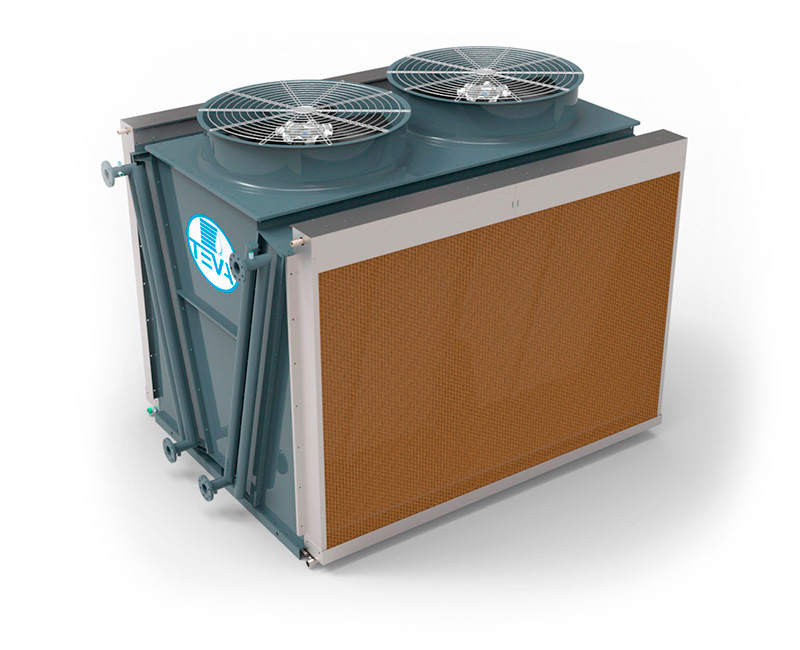The experience acquired over decades in all matters relating to the behaviour and properties of air and cooling water / ammonia condensation led to TEVA were precursors in high-efficiency adiabatic systems free of aerosols.
The compact units of AVA series, ships fully assembled reducing installation costs on site, are free of physico-chemical water treatments and obligations arising out of the enforcement of laws relating to legionella.
The AVA series adiabatic coolers, offers equipments to dissipate up to 1.722 kW in a single unit, improving the electrical consumption of the conventional dry coolers and approaching to the outlet temperatures and optimal values of efficiency of cooling towers.
A humidifying panel or evaporative cooling pad, through which is passed the air before coming in contact with the coil is giving adiabatic systems large advantages over the dry air coolers. Part of the water contained in the panel is evaporated by the warm and dry air that passes through it, so that the air that leaves the pad is therefore cooled before performing thermal exchange. This allows to get lower temperatures of outlet cold water while electrical consumption is considerably reduced.
The AVA series pad consists of corrugated cellulose paper sheets specially impregnated with resins that ensure a strong product, with high absorbance capacity, which is protected against decomposition.
The pad angles and its structural design achieves great efficiency of evaporation and maintains a very low pressure drop at the same time, without the water drift and keeping the scale to the minimum.
Teva adiabatic systems control is managed by an own control cabinet located in the front panel of the machine, which has a local PLC, a terminal operator with touch screen in the door and a inverter control, all communicated each other using Modbus.
This powerful and flexible configuration, along with operation of the fans by frequency converter, allows adaptation to different working conditions, optimising both energy and water.
From the operator terminal user may make different settings:
- Outlet water temperature set-point
- Timing of solenoid valves for the water circuit
- Display and confirmation of alarms and faults
- The place of control selection
- local, from the own screen
- remote through discrete signals
- field bus communication (optional)
We can offer a variant with webserver for remote monitoring over the internet.
In the AVA adiabatic cooler series the thermal exchange surface is provided by two coils mounted on V shape, built with tube and fin features according data in the technical characteristics table. The fins are of continuous sheets stamped with undulations, studied to optimize the efficiency of heat exchange, and collars maintaining the separation between them.
The tubes are mechanically expanded, ensuring effective contact with collars fins and are interconnected forming circuits designed to improve the transmission efficiency with low pressure loss.
Axial fan type formed by adjustable pitch blades anchored to a cube in injected aluminium, with high efficiency airfoil profile and moulded in polypropylene reinforced with fiberglass (PPG).
The fan cylinder and the roof of the AVA equipment are constructed in reinforced polyester, with an aerodynamic design at the outlet of the air, improving the power consumption and noise level.
The three phase electric motor, directly coupled to a axial fan, is of closed type with IP55 protection according IEC 34-5 y UNEL 05515. An hermetic connections box transferred outside of the equipment for an easy connection. Each motor / fan are equipped with a removable fan guard made with frame and mesh in steel and hot dip galvanized after fabrication.
All components that serve as support or frame to the coil, as well as the support of the fans structure are constructed with panels or profiles of galvanized steel with thickness of 2 or 3 mm. that provides a superb consistency and firmness to the structure and bearing capacity of the machine, as well as resistance to the passage of time necessary to ensure continued service.
The legs or feet of anchor of the whole are also built with 4 mm thick galvanized sheet profiles.
All elements of the structure are subjected to a cycle of degreasing, phosphatization and applying of two-component polyurethane varnish prepared expressly for the protection of equipment exposed to air pollution.


